They say everything is bigger in Texas, and some of the biggest flying birds in North America live in the Lone Star State.
Texas has everything from desert to swamp, and everything in between. It is the second-largest state in the U.S. and the wildlife is diverse, with thousands of different species.
Let’s take a look at the 25 biggest flying birds in Texas.
1. Largest Wingspan in Texas: American White Pelican (Pelecanus erythrorhynchos)
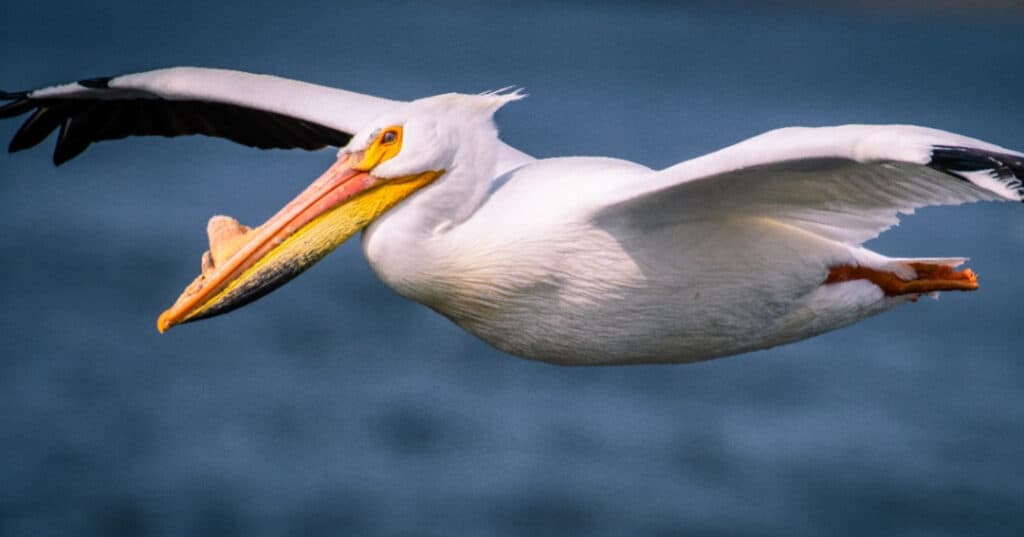
American white pelicans have the largest wingspan of any bird in Texas.
©Jerek Vaughn/Shutterstock.com
Impressive by any definition, American white pelicans have the second-largest wingspan in North America — the California condor has the largest. However, there are no condors in Texas. So, American white pelicans are the largest flying bird in Texas by wingspan.
American white pelicans can hold up to three gallons of water in that huge bill they carry around. When they fish, pelicans scoop up fish and water, then tip their bills forward to drain the water but keep the fish.
They’re more common in Texas from November to February, American white pelicans are migratory. Before heading south for the winter, they breed in remote inland lakes of North America.
- Length: 60 – 63 inches
- Weight: ~14.3 pounds
- Wingspan: 96 – 110 inches
2. Longest Bird in Texas: Trumpeter Swan (Cygnus buccinator)

From nose to tail, trumpeter swans are the longest of any bird in Texas.
©iStock.com/Zeke1
Trumpeter swans are easily one of the heaviest flying birds in the world and males can exceed 72 inches long from bill to tail. At up to 25 pounds, they’re nearly as heavy as mute swans.
However, unlike mute swans, trumpeter swans are native to North America. Trumpeter swans usually mate for life but will take another mate if theirs dies. They are also territorial and aggressively protect their nesting area and young.
Adults are solid white birds with black bills and legs, whereas juveniles are usually dusky gray with pink on their black bills.
- Length: 58 – 72 inches
- Weight: ~25 pounds
- Wingspan: 72 – 102 inches
3. Heaviest Bird Flying in Texas: Mute Swan (Cygnus olor)
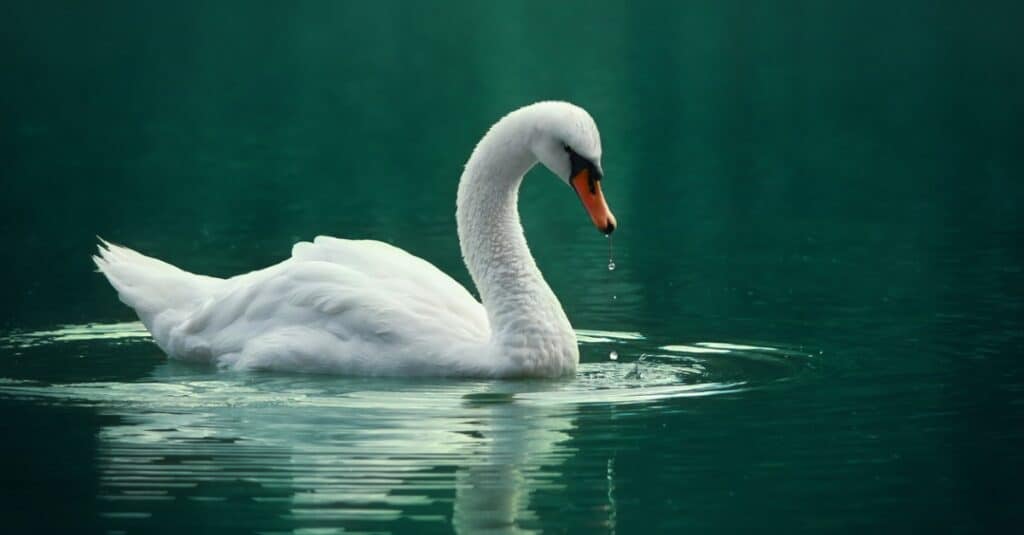
The mute swan is the heaviest of the swimming birds.
©iStock.com/Arina_Bogachyova
Although not native, and invasive, mute swans are the current heavy-weight among the birds flying in Texas, weighing up to 26 pounds.
They were introduced into ornamental ponds and lakes because of their beauty. However, nature always finds a way and the swans escaped captivity. After escaping, these big birds began breeding and causing problems for native wildlife. During the breeding season, adults can be aggressive, often chasing off things they perceive as a threat.
However invasive they are, mute swans have beautiful solid-white plumage with graceful necks, an orange bill with black around the base, and black legs. The only difference between males and females is their size: males tend to be larger.
- Length: 56 – 62 inches
- Weight: ~26 pounds
- Wingspan: 84 – 96 inches
4. Tallest Bird Flying in Texas: Whooping Crane (Grus americana)

©Kent Ellington/Shutterstock.com
Whooping cranes are endangered and one of the rarest bird species in North America. They’re migratory, breeding in the shallow wetlands of Canada and wintering in southern Texas.
These very tall birds stand nearly five feet tall, making them the tallest birds in all of North America — not just Texas. Whooping cranes forage in water and on land, eating plants, berries, and seeds. They’re most common in southern Texas from mid-September to March or early April.
Whooping cranes are mostly white birds with rust-colored patches on their heads and black beaks, legs, and flight feathers.
- Length: 52 inches
- Weight: ~12.8 pounds
- Wingspan: 87 inches
- Standing height: 4.9 feet tall
5. Wild Turkey (Meleagris gallopavo)
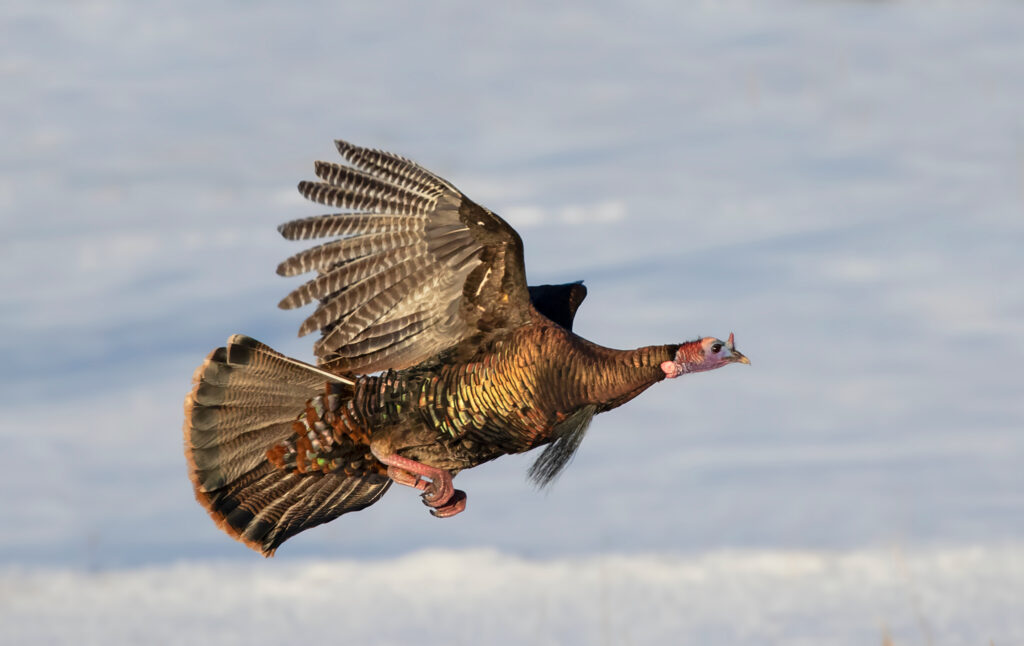
Wild turkeys can fly short distances up to a quarter-mile.
©Jim Cumming/Shutterstock.com
Although domestic turkeys cannot fly, wild turkeys are capable of short-range flight. Because of their short-range flight capabilities, wild turkeys do not migrate. They are big, beautiful birds that weigh up to 23.75 pounds with rich dark plumage.
They are present in most of Texas’ mature mixed forests with a balance of openings and cover. Wild turkeys love eating acorns, nuts, and berries.
- Length: 43.3 – 45.3 inches
- Weight: 5.5 – 23.75 pounds
- Wingspan: 49.2 – 56.7 inches
6. Canada Goose (Branta canadensis)
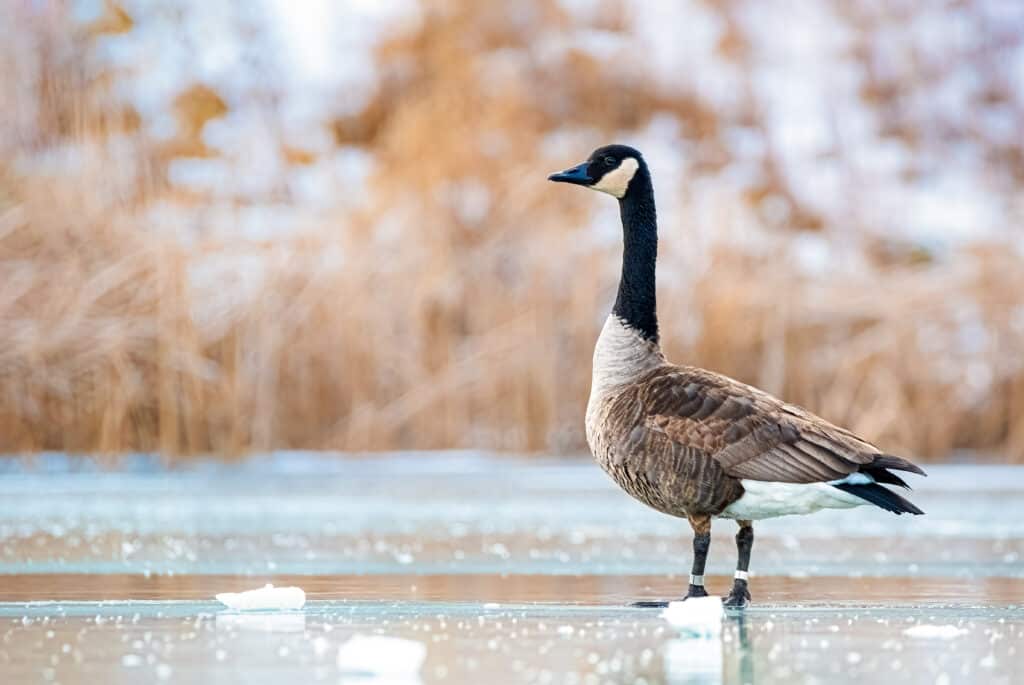
Canada geese have black necks and faces with white neckbands.
©Rogney Piedra Arencibia/Shutterstock.com
Next on our list, Canada geese breed in Canada and then migrate to southern U.S. states for the winter, however, some stay all year long.
Canada geese have brown bodies with lighter-colored chests and white rumps. But the most notable identification factor is as plain as the markings on their head: they have black necks with bright white neckbands
These active foragers eat grasses, small aquatic insects, and fish and live almost everywhere in North America, including most of Texas. Essentially, wherever they find food and water.
- Length: 25 – 45 inches
- Weight: ~14.3 pounds
- Wingspan: 70 – 75 inches
7. Bald Eagle (Haliaetus leucocephalus)

These huge birds have up to nine-foot wingspans, the third largest in North America.
©PHOTOOBJECT/Shutterstock.com
Easily identified with its white head feathers and brown plumage, bald eagles have a seven to nine-foot wingspan — it’s the third largest in North America.
However, the bald eagle’s call doesn’t really suit this majestic bird. You might expect to hear a big, loud call. But these gorgeous birds got stuck with a high-pitched squeak!
Although they’re more common from October to March, you can see them all year in Texas. They prefer broad, open expanses of water with fish. But they’re opportunistic and will eat anything they can.
- Length: 34 – 43 inches
- Weight: ~10.5 pounds
- Wingspan: 72 – 96 inches
8. Golden Eagle (Aquila chrysaetos)
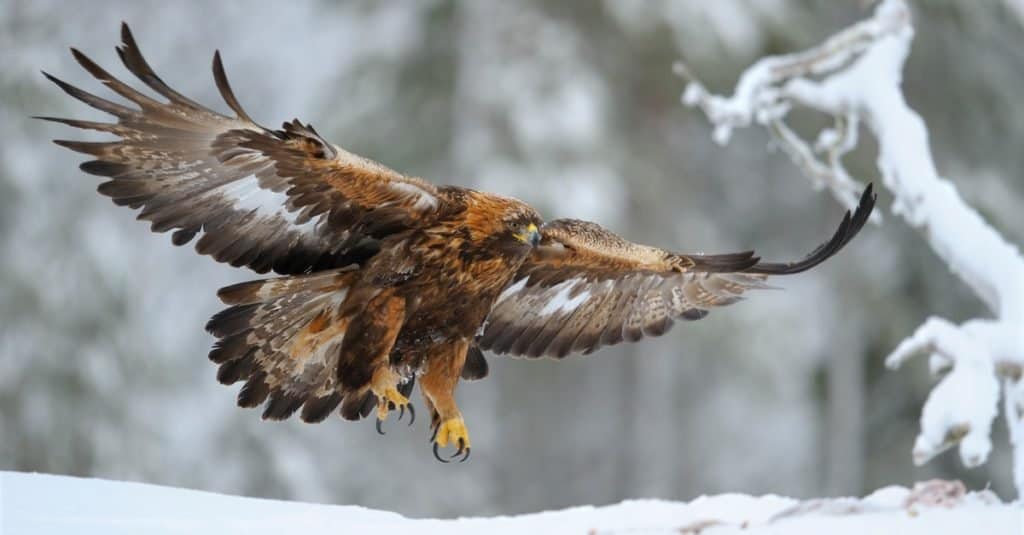
These birds like hunting in pairs, where one wears down the animal and the other goes in for the kill.
©Vladimir Kogan Michael/Shutterstock.com
Although golden eagles are widely distributed, their Texas range is mostly limited to the western side of the state.
Golden eagles are just as big as bald eagles, and many migrate south from breeding grounds in Canada and Alaska. These raptors make their homes in mountainous regions far above the treeline. They typically hunt animals the size of rabbits and prairie dogs but may also take down larger prey occasionally.
- Length: 27 – 38 inches
- Weight: ~10 pounds
- Wingspan: 72 – 96 inches
9. Sandhill Crane (Antigone canadensis)
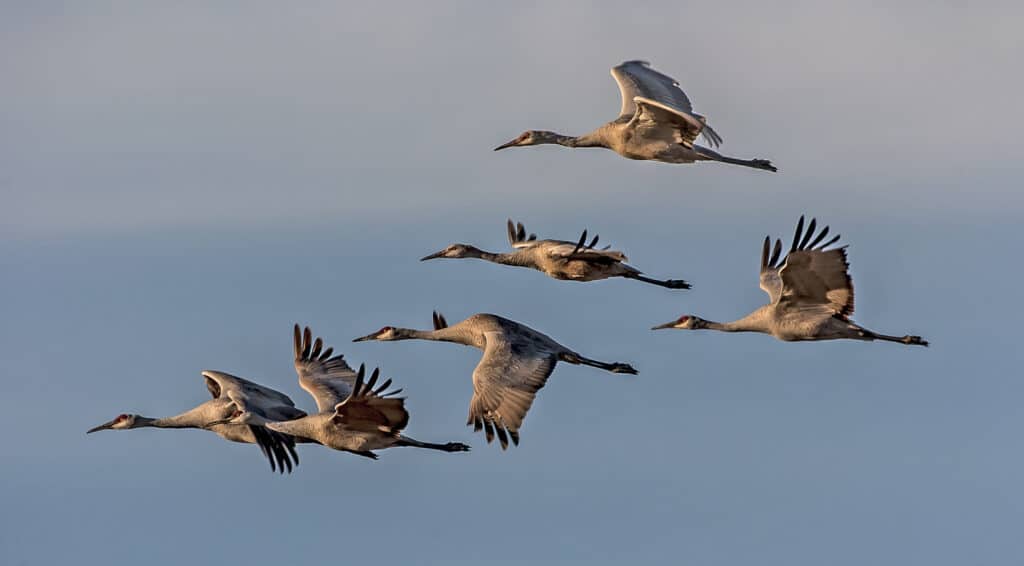
With an up to 90-inch wingspan, sandhill cranes are among the biggest flying birds in Texas.
©Tom Zeman/Shutterstock.com
These migratory birds are usually only in Texas from October to March because sandhill cranes breed in Canada and northern U.S. states. Their impressive wingspan can reach 90 inches, making them easily one of the biggest birds flying over Texas.
They are tall and heavy-bodied with bright-red crowns and white necks and cheeks that contrast with gray bodies. Sandhill cranes are omnivores that eat various foods, like nuts, seeds, berries, amphibians, reptiles, and small mammals.
- Length: 34 – 48 inches
- Weight: 8.25 pounds
- Wingspan: 73 – 90 inches
10. Brown Pelican (Pelecanus occidentalis)
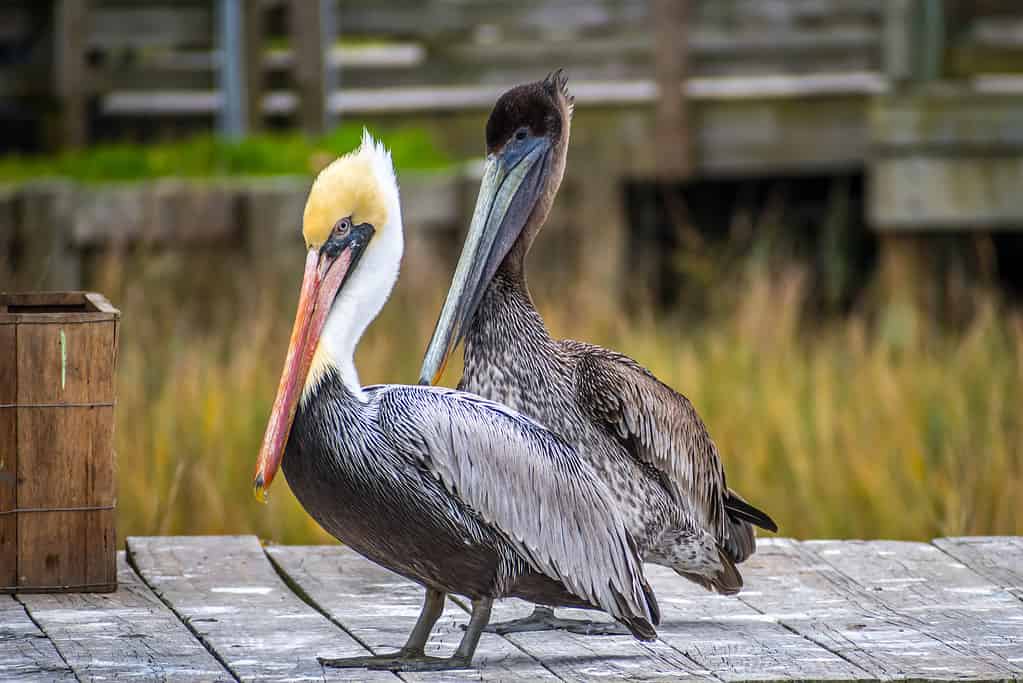
Sometimes described as “comically elegant,” brown pelicans are among the largest flying birds in Texas.
©Cheri Alguire/iStock via Getty Images
Depending on the climate where brown pelicans live, they are either migratory or live in the area all year long. In Texas, they’re most often found near shallow-water habitats like coastal marine areas and in estuaries.
Brown pelicans have a massive wingspan of up to 84 inches. Like their cousins the American white pelican, brown pelicans feast on fish they catch using their huge bills.
- Length: 48 – 50 inches
- Weight: ~8.25 pounds
- Wingspan: 78 – 84 inches
11. Osprey (Pandion haliaetus)

This fish-hunting specialist can turn its outer toe backward, and it has spiny scales on the soles of its feet to hold its slippery prey.
©BlueBarronPhoto/Shutterstock.com
These raptors can live nearly everywhere in the world except Antarctica. Ospreys are particularly fond of large water bodies where their favorite food is abundant — which is perfect because these birds mostly eat fish.
Boasting a wingspan of up to six feet, they are big with unmistakable brown and white plumage. Ospreys are more common in Texas between October and April, but these large birds are seen flying through Texas skies all year long.
Ospreys also have a superpower — they can turn their outer toe backward! Combined with the spiny scales on their soles, they can hold onto slippery fish.
- Length: 21 – 24 inches
- Weight: ~4 pounds
- Wingspan: 54 – 72 inches
12. Great Horned Owl (Bubo virginianus)
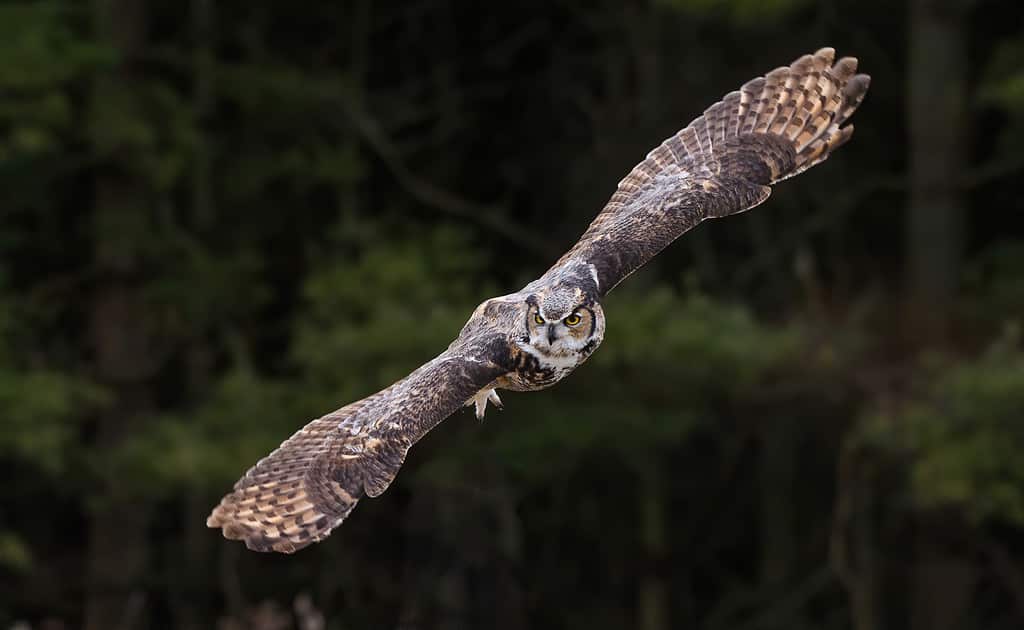
Highly adaptable, great horned owls live alongside people easily.
©yongsheng chen/Shutterstock.com
These large nocturnal birds are prevalent in Texas. However, great horned owls don’t actually have horns, because their “horns” are actually tufts of feathers.
Boasting a 57-inch wingspan, great horned owls are true silent predators. Their feathers are soft and reduce the sound created by their flapping wings to nearly nothing. In addition, their ears are slightly offset so they can more accurately locate prey at night.
Because great horned owls are highly adaptable, they can easily live in human habitats. These large owls are also fond of deserts, grasslands, and forests. Essentially, where they find nesting sites and food, they can make it a home.
- Length: 18.1 – 24.8 inches
- Weight: 2 – 5.5 pounds
- Wingspan: 39.8 – 57.1 inches
13. Great Egret (Ardea alba)

These elegant birds have all-white feathers and a wingspan of up to 55 inches.
©iStock.com/CreativeNature_nl
Snowy white and elegant in appearance, great egrets have wingspans of up to 55 inches. They are wading birds that frequent fresh and saltwater marshes, fishponds, lake edges, and tidal flats.
Seeing one flying overhead is common in Texas, almost as common as seeing them wading in shallow water as they hunt various fish and crustaceans.
- Length: 37 – 41 inches
- Weight: ~3.75 pounds
- Wingspan: 54 – 55 inches
14. Black Vulture (Coragyps atratus)
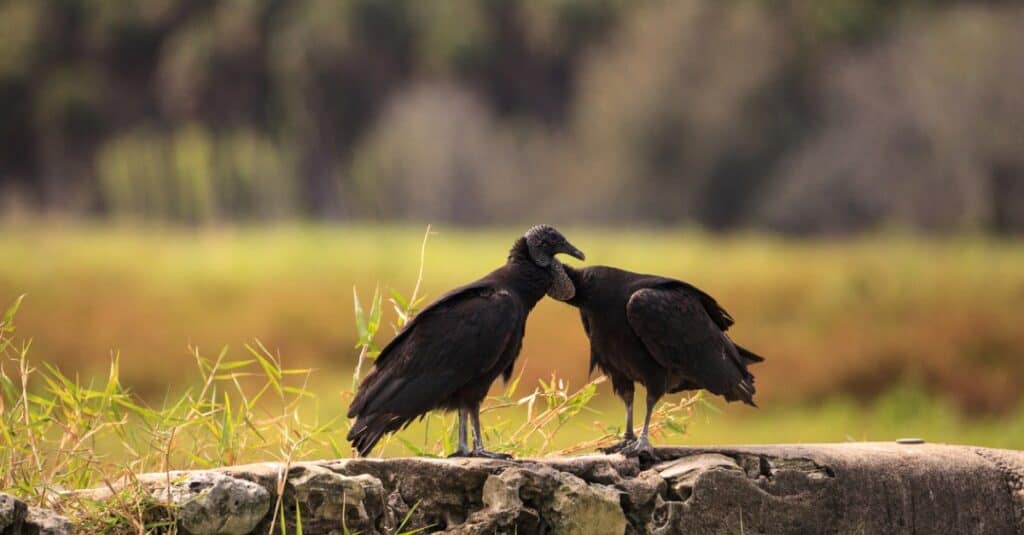
Black vultures perform aerial displays during courtship.
©iStock.com/LagunaticPhoto
In Texas, black vultures are year-round residents. These big vultures have a wingspan of up to 60 inches across. They have bald heads typical of vultures, but they have some of the blackest feathers. Black vultures also have silver-colored patches on the underside of their wings, making it look like they have fingers.
These birds will eat nearly anything. However, black vultures usually eat carrion. Their sight is relatively good, so they may be able to see their food on the ground. But they tend to rely on scavenger birds to find their latest meal.
- Length: 23 – 27 inches
- Weight: ~4.75 pounds
- Wingspan: 54 – 60 inches
15. Great Black-Backed Gulls (Larus marinus)
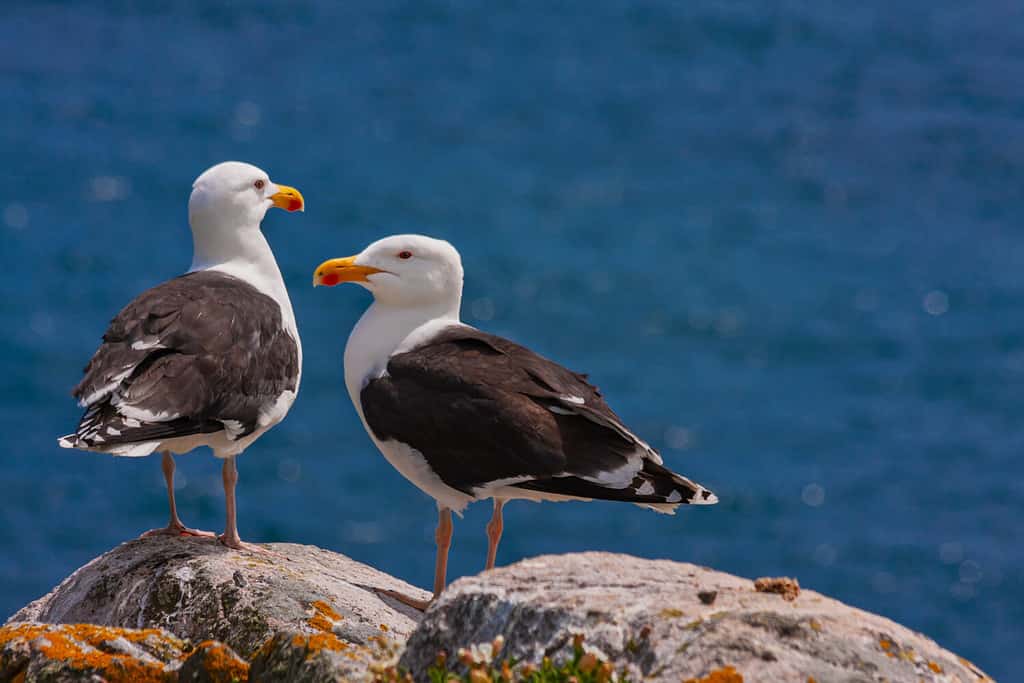
Great black-backed gulls are the biggest gulls in the world.
©Nicola_K_photos/Shutterstock.com
Although extremely rare in Texas, they are sometimes spotted along the Gulf Coast. These large gulls are opportunistic feeders that eat nearly anything. Their usual fare is fish, but they also eat eggs, crabs, and even other birds.
Great black-backed gulls are the largest gulls in the world and have white heads, yellow bills with a red spot, and pink legs. However, their name comes from their backs and wings, which are black.
- Length: 25 – 31 inches
- Weight: 4 pounds
- Wingspan: 60 – 65 inches
16. Ferruginous Hawk (Buteo regalis)
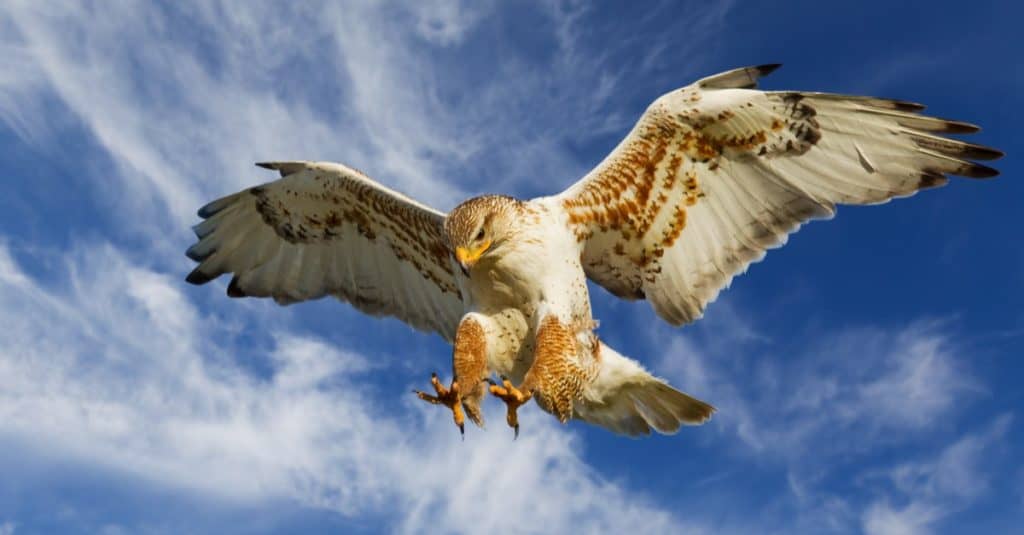
These hawks have big heads and wings, and feathered legs.
©Stephen Mcsweeny/Shutterstock.com
This is the biggest hawk species in North America. A ferruginous hawk’s wingspan is over four feet and sometimes approaches five. They have big heads and wings and come in two different color morphs — light and dark.
Ferruginous hawks love the open regions in western Texas. Some of them breed as far north as southern Canada and spend November to February in Texas. This species mainly eats small mammals including cottontail rabbits, ground squirrels, and prairie dogs — depending on what’s available in their area.
- Length: 22.1-27.2 inches
- Weight: 2 – 4.5 pounds
- Wingspan: 52.4-55.9 inches
17. Turkey Vulture (Cathartest aura)

Turkey vultures’ wingspans are up to 72 inches, which allows them to soar for hours while they look for food.
©GarySang/Shutterstock.com
These vultures really do look like turkeys when they’re on the ground, but a wild turkey can’t fly like a vulture. Regardless, it’s easy to identify this bird. When they’re flying overhead, the shadow of their wings forms a light V-shape.
Like other vultures, they eat dead animals, but only if it isn’t too rotten. Because turkey vultures are adaptable, they can live happily in many different habitats but really prefer open areas near forests.
- Length: 26 – 32 inches
- Weight: ~3.25 pounds
- Wingspan: 68 – 72 inches
18. Rough-Legged Hawk (Buteo lagopus)
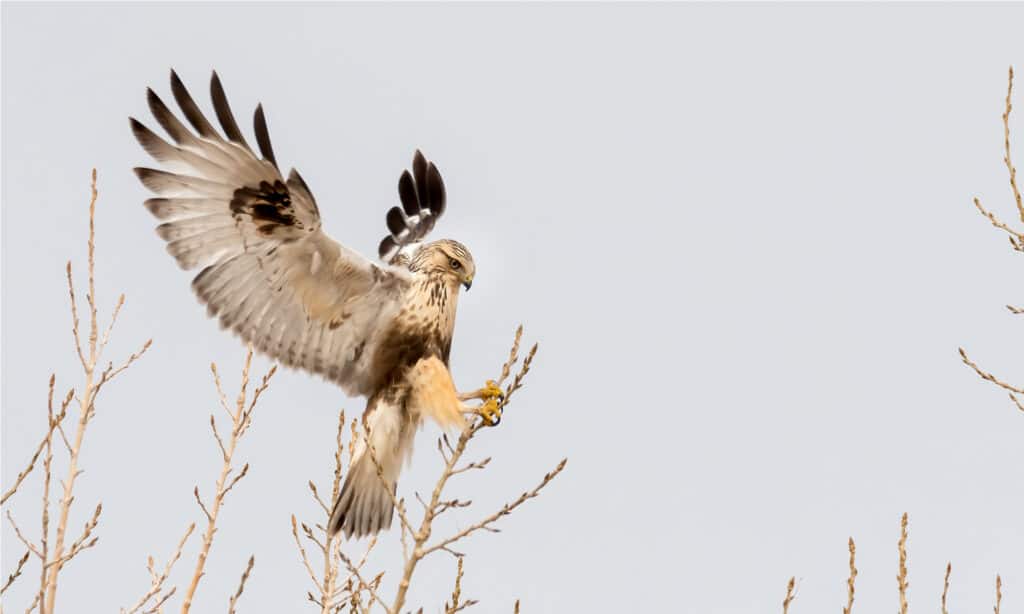
They’re rare in Texas, wintering in the northern regions of the state.
©Eivor Kuchta/Shutterstock.com
Rough-legged hawks are mostly brown but can be lighter or darker. These raptors can have a wingspan of up to 54 inches but don’t have the wide size variations you see in other birds of prey.
Unlike most hawks, rough-legged hawks have feathered legs. They are rare in Texas. However, you may see one in the northern part of the state because they spend November to March in southern climates. In spring, they migrate north again when they return to their Arctic breeding grounds.
- Length: 18.5-20.5 inches
- Weight: 1.5 – 3 pounds
- Wingspan: 52.0-54.3 inches
19. Crested Caracara (Caracara cheriway)
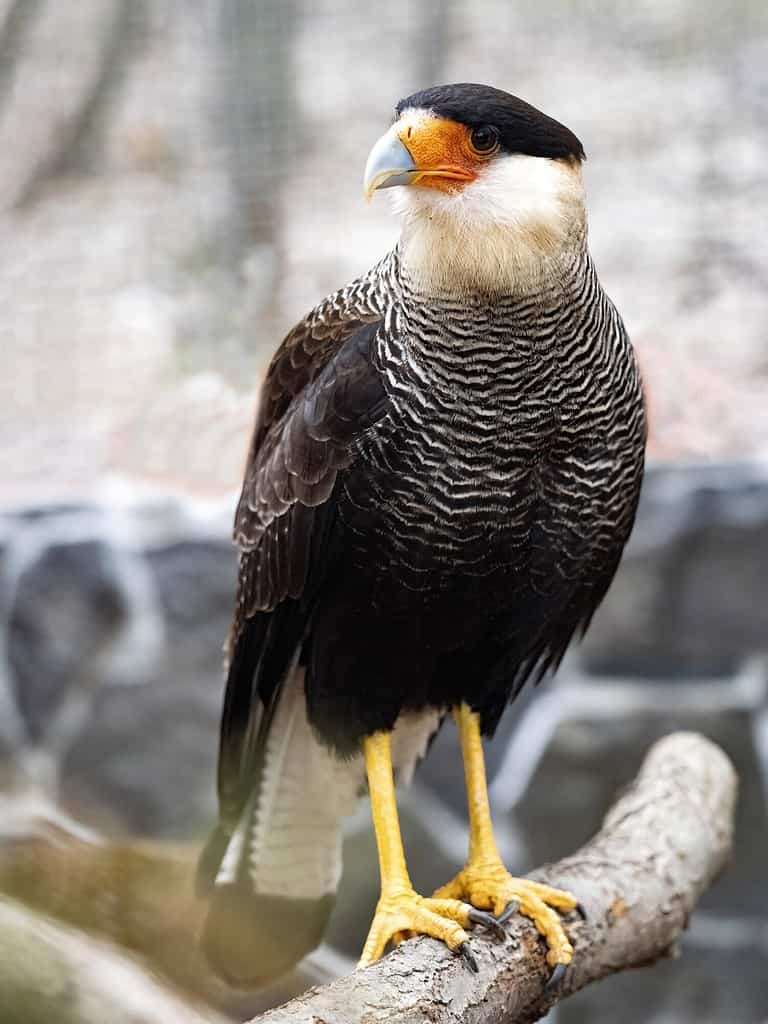
Crested caracaras will eat just about anything they can grab, even keeping vultures from their food.
©Vladislav T. Jirousek/Shutterstock.com
This opportunistic hunter is a common sight flying in Texas. Crested caracaras have wingspans of up to four feet, have massive orange bills, black scruffy crowns, and feed on carrion. They’re also sometimes aggressive toward other birds when they’re eating.
They live in various habitats that are open or semi-open, like deserts, savannas, agricultural fields, and prairies. Because they like to watch from high up, people often spot them on fence posts, high up in trees, or at the top of a cactus.
- Length: 20 – 25 inches
- Weight: ~2 pounds
- Wingspan: 45 – 48 inches
20. Pileated Woodpecker (Dryocopus pileatus)

Pileated woodpeckers are the biggest
woodpecker
species in North America.
©Vlad G/Shutterstock.com
This is the biggest woodpecker in North America, and although it isn’t as big as the other birds on our list, it is a big bird. Pileated woodpeckers can have 29-inch wingspans and are most common in east Texas. However, they don’t migrate, instead choosing to stick out the cold weather.
You’ll spot pileated woodpeckers easily — they have a shocking flame-red crest that’s unmistakable.
- Length: 15.8 – 19.3 inches
- Weight: 8.8 – 12.3 ounces
- Wingspan: 26 – 29.5 inches
21. Wood Stork (Mycteria americana)
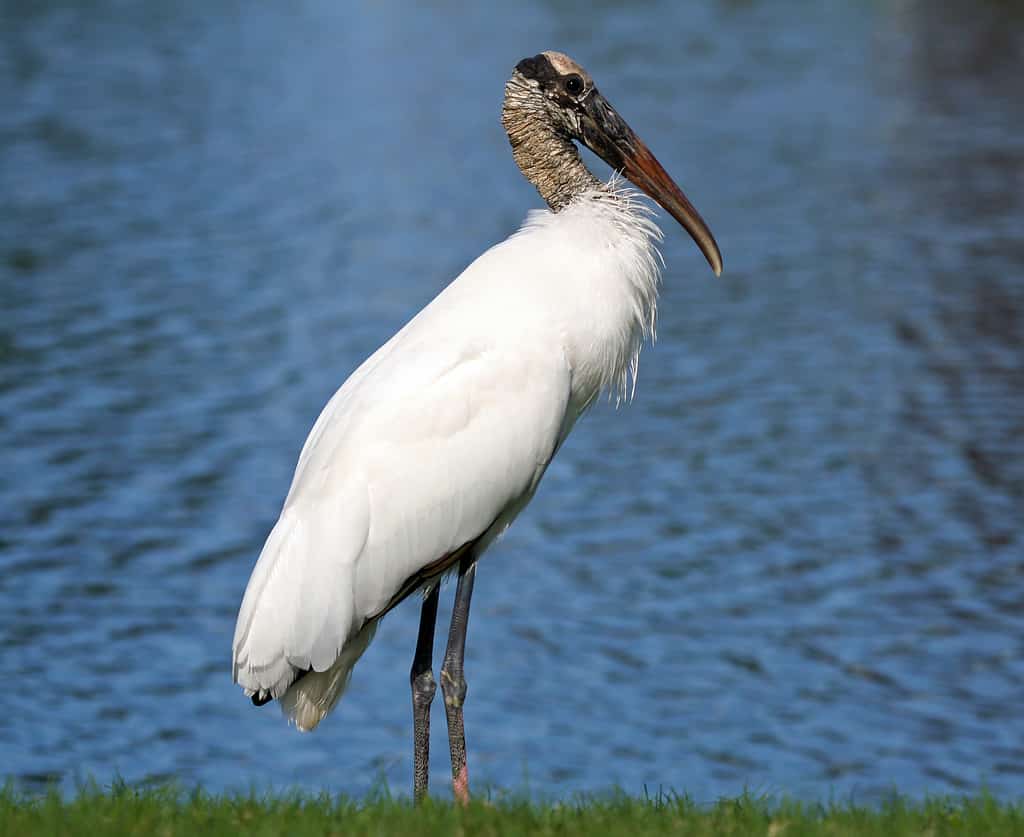
The wood stork lives in cypress swamps, marshes, ponds, and lagoons in the southern United States.
© Googie man at en.wikipedia / CC BY-SA 3.0 – License
Wood storks breed in Texas from June to mid-November; however, a few may stay near Houston all year long. Wood storks have long, bulky bills and bald heads. If that wasn’t striking enough, their pure white bodies with black flight feathers make them memorable birds.
These wading birds spend most of their time in forested wetlands, where they prefer areas with lots of trees, especially during breeding season.
- Length: 35 – 45 inches
- Weight: ~6 pounds
- Wingspan: ~65 inches
22. Snowy Owl (Bubo scandiacus)

Male snowy owls have less flecking than females.
©Tambako The Jaguar / CC BY-ND 2.0 DEED – License
Rare and considered vulnerable in Texas, snowy owls aren’t spotted flying the Texas skies often. The last confirmed sighting was in 2021. These black-flecked white owls have a wingspan of up to 57 inches. Like most birds, they aren’t very heavy but can get up to six and a half pounds.
Unlike most of their owl cousins, snowy owls are diurnal, likely because they have 24 hours of light in their Arctic summer home. Snowy owls mainly hunt small mammals, and in the Arctic eat a lot of lemmings — up to 1,600 in a single year.
- Length: 20 – 28 inches
- Weight: 3.5 – 6.5 pounds
- Wingspan: 49.5 – 57.1 inches
23. Great Blue Heron (Ardea herodias)
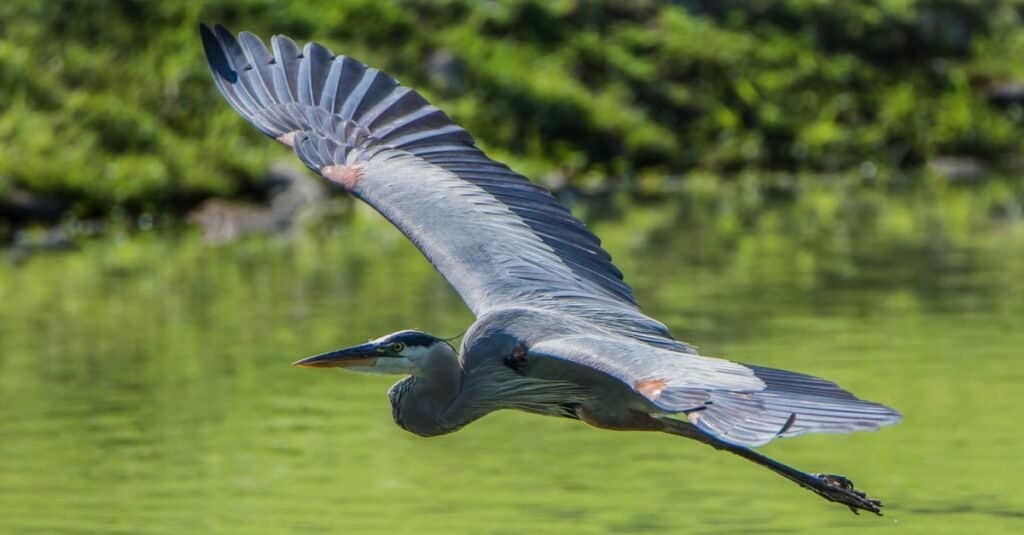
These wading birds are common sights in the shallows around ponds and lakes.
©Tom Franks/Shutterstock.com
Extremely common in Texas, great blue herons live in the Lone Star State all year long. Their wingspans can reach 82 inches, which makes great blue herons one of the biggest birds in Texas.
Great blue herons are wading birds. They use their long, pointy beak to grab fish, crustaceans, and other small prey in shallow water. Because of their aquatic diet, they are most common in ponds, marshes, at the edges of lakes, and other shallows. This species is also easily identified: they have slate blue body feathers, dark crowns, and white chins.
- Length: 46 – 52 inches
- Weight: ~8 pounds
- Wingspan: 77 – 82 inches
24. Caspian Tern (Hydroprogne caspia)
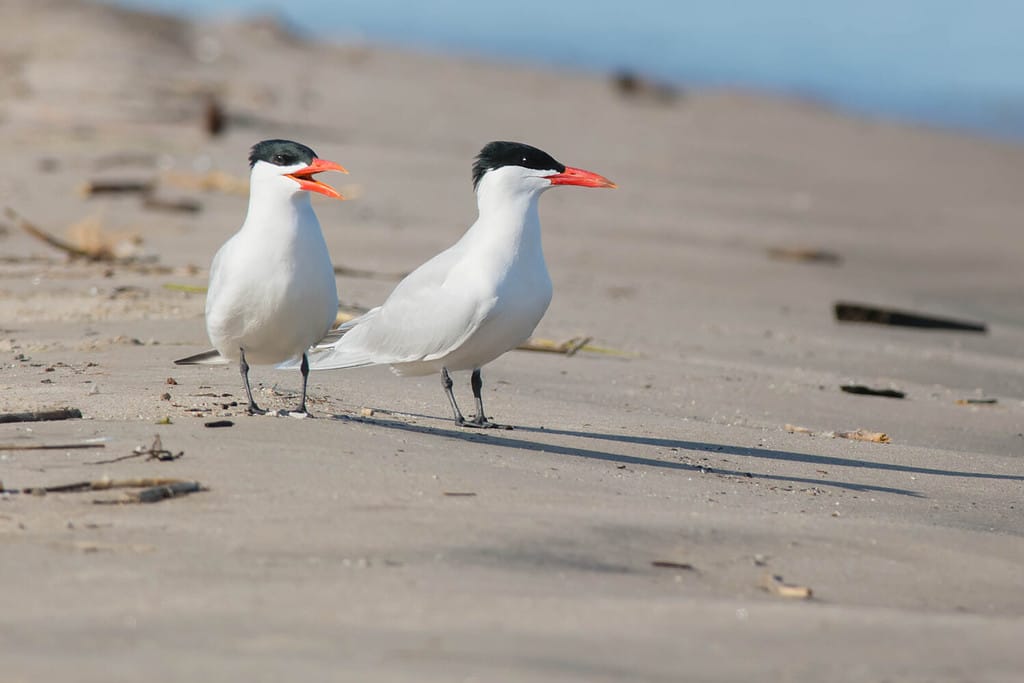
The largest tern in Texas, Caspian terns are easily identified.
©Paul Reeves Photography/Shutterstock.com
This tern isn’t just the biggest tern in Texas but in the world. Caspian terns have an astounding wingspan of up to 57 inches.
Named for the Caspian Sea, where they are common, Caspian terns are mostly sea-faring birds. However, they nest in barren dredge spoil, shell beaches, and islands along Texas’ Gulf Coast. Some stay year-round, but most are migratory and only spend winters in Texas.
These birds are easy to identify because they have large heads, red beaks, slightly forked tails, and a raspy call.
- Length: 19 – 24 inches
- Weight: 1.1 – 1.72 pounds
- Wingspan: 50 – 57 inches
25. Roseate Spoonbill (Platelea ajaja)
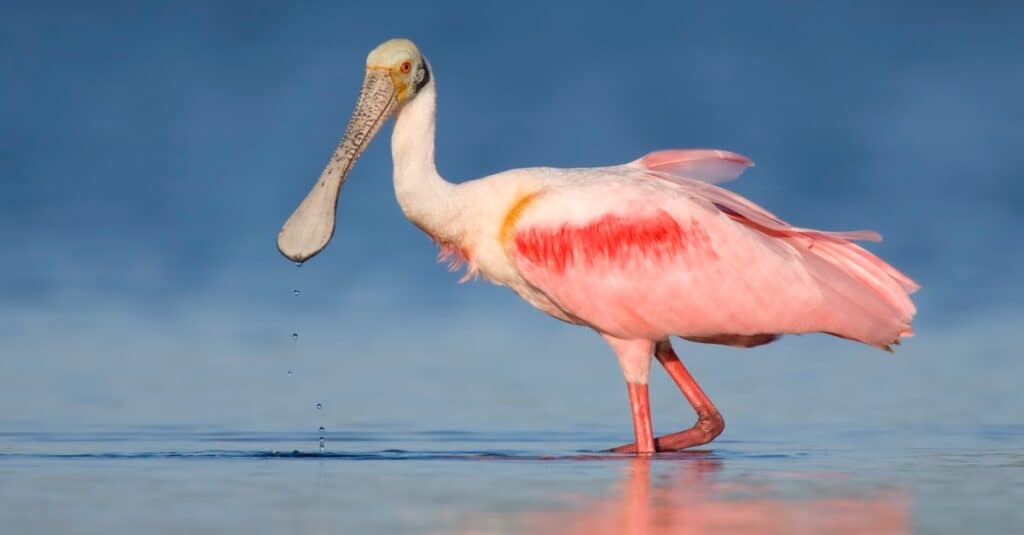
The roseate spoonbill’s pink plumage comes from their diet of crustaceans.
©iStock.com/Canon_Bob
Roseate spoonbills make their homes along the Texas coast, where they are year-round residents. Their pale pink plumage is the result of ingesting the carotenoids that their favorite foods contain. So, just like flamingos, roseate spoonbills would be mostly white without the crustaceans they eat.
Their 52-inch wingspan and beautiful coloring make them a welcome sight along the coast!
- Length: 28 – 34 inches
- Weight: 2.6 – 4 pounds
- Wingspan: 47 – 52 inches
Summary of 25 Biggest Flying Birds in Texas
| Type of Bird | Size Stats |
|---|---|
| American White Pelican | Length: 60 – 63 inches Weight: ~14.3 pounds Wingspan: 96 – 110 inches |
| Trumpeter Swan | Length: 58 – 72 inches Weight: ~25 pounds Wingspan: 72 – 102 inches |
| Mute Swan | Length: 56 – 62 inches Weight: ~26 pounds Wingspan: 84 – 96 inches |
| Whooping Cran | Length: 52 inches Weight: ~12.8 pounds Wingspan: 87 inches Standing height: 4.9 feet tall |
| Wild Turkey | Length: 43.3 – 45.3 inches Weight: 5.5 – 23.75 pounds Wingspan: 49.2 – 56.7 inches |
| Canada Geese | Length: 25 – 45 inches Weight: ~14.3 pounds Wingspan: 70 – 75 inches |
| Bald Eagle | Length: 34 – 43 inches Weight: ~10.5 pounds Wingspan: 72 – 96 inches |
| Golden Eagle | Length: 27 – 38 inches Weight: ~10 pounds Wingspan: 72 – 96 inches |
| Sandhill Crane | Length: 34 – 48 inches Weight: 8.25 pounds Wingspan: 73 – 90 inches |
| Brown Pelican | Length: 48 – 50 inches Weight: ~8.25 pounds Wingspan: 78 – 84 inches |
| Osprey | Length: 21 – 24 inches Weight: ~4 pounds Wingspan: 54 – 72 inches |
| Great Horned Owl | Length: 18.1 – 24.8 inches Weight: 2 – 5.5 pounds Wingspan: 39.8 – 57.1 inches |
| Great Egret | Length: 37 – 41 inches Weight: ~3.75 pounds Wingspan: 54 – 55 inches |
| Black Vulture | Length: 23 – 27 inches Weight: ~4.75 pounds Wingspan: 54 – 60 inches |
| Great Black-Backed Gulls | Length: 25 – 31 inches Weight: 4 pounds Wingspan: 60 – 65 inches |
| Ferruginous Hawk | Length: 22.1-27.2 inches Weight: 2 – 4.5 pounds Wingspan: 52.4-55.9 inches |
| Turkey Vulture | Length: 26 – 32 inches Weight: ~3.25 pounds Wingspan: 68 – 72 inches |
| Rough-Legged Hawk | Length: 18.5-20.5 inches Weight: 1.5 – 3 pounds Wingspan: 52.0-54.3 inches |
| Crested Caracara | Length: 20 – 25 inches Weight: ~2 pounds Wingspan: 45 – 48 inches |
| Pileated Woodpecker | Length: 15.8 – 19.3 inches Weight: 8.8 – 12.3 ounces Wingspan: 26 – 29.5 inches |
| Wood Stork | Length: 35 – 45 inches Weight: ~6 pounds Wingspan: ~65 inches |
| Snowy Owl | Length: 20 – 28 inches Weight: 3.5 – 6.5 pounds Wingspan: 49.5 – 57.1 inches |
| Great Blue Heron | Length: 46 – 52 inches Weight: ~8 pounds Wingspan: 77 – 82 inches |
| Caspian Tern | Length: 19 – 24 inches Weight: 1.1 – 1.72 pounds Wingspan: 50 – 57 inches |
| Roseate Spoonbill | Length: 28 – 34 inches Weight: 2.6 – 4 pounds Wingspan: 47 – 52 inches |
The photo featured at the top of this post is © FloridaStock/Shutterstock.com
Thank you for reading! Have some feedback for us? Contact the AZ Animals editorial team.






